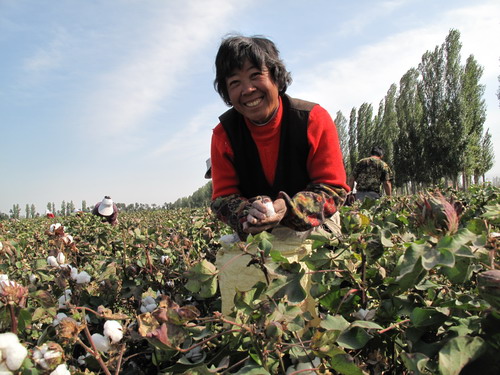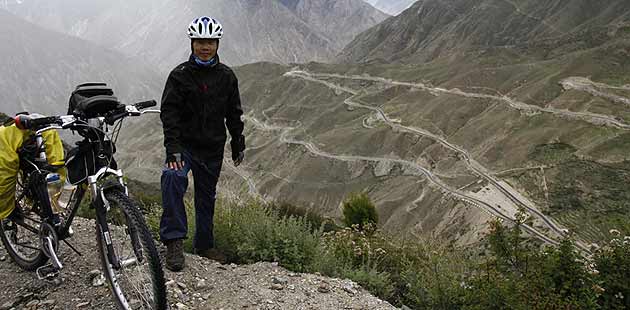Harsh harvest looms for Xinjiang cotton growers
Updated: 2011-10-11 13:31
By Shao Wei (China Daily)
|
|||||||||||
|
Zhang Yurong from Nanyang, Henan province, is looking forward to a big payday from this, her sixth season picking cotton in Xinjiang Uygur autonomous region. She works in XPCC fields. [Photo/China Daily] |
80 kg a day
Zhang Yurong is one of them.
The 50-year-old woman covers herself from head to toe to work in the fields. The covering not only prevents sunburn and insect bites, but also means human hair does not mix with the cotton, which would reduce its quality.
"This is my sixth year to come to Xinjiang as a cotton picker," Zhang said. "It's rare to see such large land and high-quality cotton in my hometown in Henan. I am a farmer and content to work for the cotton harvest here, even though the work always makes my back ache at night."
Zhang gets up to work at 5 am and continues until 9 pm, with only a 30-minute break at noon for a quick lunch in the field. She can pick 80 kg of cotton every day, a little less than some young co-workers.
"My son works in Guangzhou and brought 15,000 yuan back home last year. You know, I earned the same from cotton picking here.
"It's much more than what I earned back home. I guess I can earn more money this year," she said with a big smile.
"Young people, born in the 1980s and 1990s, have deserted the cotton areas because they can obtain better jobs and more money in the South," Li, the labor contractor, said. "It's impossible to stop young villagers from seeking fortunes in urban areas unless agricultural policy makes it more profitable for them to work in fields than on construction sites or in factories."
Labor competition
Xinjiang, the country's major cotton production region, had 1.4 million hectares planted in cotton last year and produced 2.5 million tons, about one-third of the country's total, according to local statistics.
The region needs almost a million cotton pickers every year for the 10-week harvest period through November. The majority of workers, mostly women, come from Gansu and Qinghai provinces and Ningxia, all in the far west, and from China's most populous province, Henan, in the central region.
This year, demand far exceeded supply.
Qinghai, for example, was expected to be the source of about 70,000 cotton pickers. But as of Sept 16, when the last special train carried farmworkers to Xinjiang, only about 35,000 had arrived.
"We are still crying for about 100,000 migrant laborers," said Li Jianjun, director of the labor managerial department of the Labor and Social Security Bureau, at XPCC.
The corps is responsible for about one-sixth of the country's cotton output and the main cotton production area in Xinjiang. It planned to employ 400,000 laborers to pick cotton, which accounts for about 70 percent of the corps' annual income, he said.
But the number of migrant pickers working for XPCC has dropped 10 percent each year since 2009, Li said. He attributed that to the labor shortage nationwide and to an increased demand for general laborers in Xinjiang.
Infrastructure construction projects in Xinjiang have provided thousands of job opportunities under a partnership program, involving 19 provinces and municipalities, that the central government kicked off at the beginning of this year.
At the same time, the central government is adjusting its agricultural policies to ensure more profit for inland farmers. As a result, Li said, many farmers may prefer not to go all the way to Xinjiang to make ends meet.
In time, they may not be needed. "The irreversible trend," Li said, is toward mechanical cotton picking.
Related Stories
China's cotton import down 13.8% in Aug 2011-10-08 09:11
China launches temporary cotton reserve 2011-09-09 09:57
Cotton production set to rise for first time in four years 2011-08-26 10:56
China July cotton imports up 30.89% from June 2011-08-11 11:40
- Transport data raise privacy concerns
- Regulator to review Beijing Jingkelong IPO
- City govt fails to clean up pollution
- Letter calls Gucci stores 'sweat shops'
- City's Wal-Marts to close for 15 days
- China IPOs shrink to two-year low in Q3
- Oil, gas tax rate moves to value base
- CSR to build Melbourne HQ














